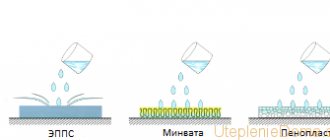Nikolay, Yekaterinburg asks a question: Good afternoon! In the summer we bought a country house, drilled a well, and installed water. At first we thought that we would only use the house in the warm season, but then we realized that the dacha brings pleasure in winter too.
Please tell me how to insulate the pipe from the well so as not to be left without water? The expert answers: In order not to be left without water with the onset of frost, you need to decide in advance how to insulate the pipes from the well and the well itself. If the well is already protected from the cold, then you should also worry about the water supply leading to the room. The best option would be to lay the pipe in the ground at a depth below the freezing point.
If for some reason this cannot be done, then the water supply should be carefully closed from the cold. However, this will not be superfluous if pipes are laid in deep trenches, because winters can be very harsh. There are several ways to solve the problem. The choice is determined by the preferences of the owners and acceptable amounts of material costs. For example, you can use a heating cable, which is laid both inside the pipe and on the outside, but this method requires additional energy costs and confidence in an uninterrupted supply of electricity. A more practical method would be when which uses an air gap: water pipes are laid inside wider pipes made of propylene. But the most reliable was and remains the option of winding pipes with heat-insulating materials.
Modern industry offers a wide choice of means used for winding: mineral wool, glass wool, tow; basalt cylinders; polyethylene foam shell; polyurethane foam insulation; polystyrene foam, polystyrene foam, penoline; penoizol. It should be noted that the use of penoizol in small areas is impractical, since it requires special equipment and has a high cost. The selected material must be of good quality and be absolutely dry. The pipes should be securely fixed. If you follow these recommendations, you will never have problems with water. Share a useful article: Related articles:
If you are still in doubt about whether it is worth insulating your water supply, we will answer you straight, of course it is worth it.
We believe that the best way to do this is to lay it below the freezing point of the ground during the season. This is important, because if this is not done, the water in the pipes may simply freeze, and this can lead to very serious consequences. If you do not know how to insulate a water supply from a well to a house, see the information below.
The main steps will be described here. As for the insulation itself. We recommend laying the pipe in the same pipe, only larger in diameter.
In the gaps you can place polystyrene foam, cotton wool or polyurethane foam. There is another way to insulate pipes. You just need to lay them in the trenches.
Be sure to check the insulation for dryness.
Be aware that wet insulation is not effective enough, and therefore dry insulation should be used. Therefore, laying pipes in the mud would be considered a deliberate mistake. You can make this mistake if you want to place the pipes at the level of groundwater type.
It is not recommended to do this, as you will simply throw money away. Be very careful.
In the event that you cannot bury the pipes properly and thereby insulate it, you can use an extraordinary method. If you urgently need water in winter, just warm up the pipes. But be careful, it can be dangerous.
How to insulate a water pipe in the ground?
Don’t be afraid to experiment; believe me, it’s quite possible to insulate pipes yourself.
You will need a little time and small funds. Let us remind you that if the pipe is already frozen solid, all that remains is to replace it. Unfortunately, this is the only safe solution.
The material from which the pipe is made will be of great importance. If we have metal-plastic in front of us, be prepared that when it freezes, water will mercilessly tear it apart and insulation is unlikely to help here.
When installing pipes, immediately plan how you will insulate them. You definitely need to remember that the water supply has two most vulnerable areas. They are located directly on the street.
They can also be located in a room where there is no heating.
If you need to insulate pipes that are located in the basement, where there is most often no heating, be extremely careful. in this case there are some nuances. Materials for insulation may be different.
See here for cutting into a high pressure water pipe!
But the main thing is that they should be united by good quality and reliability. After all, the availability of water in your home will depend on the state of labor. The materials must be water-repellent and heat-insulating, then the insulation of the pipes will be successful.
You can also watch the video INSULATION OF WATER PIPES, INSTALLATION OF HEATING CABLE
When installing a water supply system, special attention should be paid to the insulation of the pipe. If the water in it freezes, the pipeline will rupture and will need to be replaced. And this means re-digging trenches and installing the main line. That is, all installation steps must be performed again, which is associated with large monetary and labor costs.
How to insulate a pipe from a well to a country house
Freezing of pipes can lead to a burst
Regardless of the choice of thermal insulation, when laying it, you should check the material for dryness. Do not forget that wet insulation is ineffective, so you should use only dry thermal insulation, and also take care of high-quality waterproofing of pipes in the ground. It would be a mistake to lay pipes in wet soil or in rainy weather.
Basalt wool should not be used for work in the ground, as this material can absorb moisture. Manufacturers are ready to offer special shells made of polystyrene foam, extruded polystyrene foam or PPU (polyurethane foam) for thermal insulation of pipes. A more economical option is to wrap the pipes in foil foam.
When laying pipes, plan how you will insulate the underground water supply and pumping station in the country in the future. It must be remembered that the most vulnerable area of water supply and sewerage pipes is the entrance of communications into the house and their exit from the ground in the basement. It is especially important to insulate the pipes in the basement if the blind area of the house and the basement walls have not yet been insulated, otherwise the pipes can freeze and cause a breakthrough.
Methods for insulating a water pipe ↑
Before you figure out how to insulate a pipe, you need to determine what exactly in the area from the well to the house requires insulation:
- If the main line is laid at a depth below the freezing level, there is no need to insulate it; If the entrance to the house is located above the freezing level, it needs to be insulated; If there is significant frost in the region or if it is impossible to lay a water supply system at great depths, the entire main line must be insulated.
Having determined the scope of installation work associated with insulation, you will have to choose the option that seems most profitable, reliable and preferable.
Content
- Methods for insulating a water pipe
- How to insulate a well and water supply system for the winter with your own hands
- Characteristics of insulation
- Heating cable for water supply
- Tips for installing insulation
When installing a water supply system, special attention should be paid to the insulation of the pipe. If the water in it freezes, the pipeline will rupture and will need to be replaced. And this means re-digging trenches and installing the main line. That is, all installation steps must be performed again, which is associated with large monetary and labor costs.
How to insulate a well and water supply system for the winter with your own hands ↑
Working with modern materials is very easy
Place a special insulating material on the pipes: Merylon, shell (foam plastic), basalt fiber. They have the shape of a pipe and vary in diameter.
The installation method in this case consists of threading the pipes into the insulation tubes. Fasten the heating cable to the pipe. It independently regulates the temperature and heats up if necessary, which will prevent the water in the pipe from freezing. It will need to be strengthened to the surface and covered with a layer of insulation or waterproofing. Use a ready-made insulated pipe.
It consists of two pipes that differ in diameter, and insulation is laid in the internal distance between them, usually having a fibrous structure: fiberglass, basalt. The space can also be filled with polyurethane foam. Sometimes a heating cable is attached to the inner pipe.
Polystyrene foam can completely block the access of cold to the pipe
Make an insulated pipe with your own hands.
To do this, thread a water pipe into a large pipe. Push insulation (glass wool, basalt) tightly into the space between them. The disadvantage of this option is the possibility of voids forming or uneven laying of the insulation.
This, of course, is not a complete list of options for how to insulate a pipe; we have presented only the most common ones. Each owner can come up with others or get creative and combine the above.
It is worth noting another well-known method, which has become quite widespread due to its availability - sheets of foam plastic are laid over the water pipe running from the well to the house, because foam has high thermal insulation properties. The sheets are simply laid over the trench and covered with soil.
Heating of external water supply systems
If we consider any system, then insulation is just a way to increase the time for its temperature to decrease to a value corresponding to the environment. Therefore, sometimes you have to resort to another option to prevent water pipes from freezing - heating.
The water supply is heated using external energy sources, and there are several ways to organize this process.
Organization of water circulation
The simplest source of additional thermal energy is water, the temperature of which is higher than in the insulated section of the water supply system. If warmer water constantly replaces cooler water, the system does not freeze. For this reason, the “half-open tap” method works, when a slow but constant movement of liquid through the pipes is organized.
For cold water supply to individual housing, it is possible to periodically replace the water in the outer branch with a warmer one. In the case of supply from the main water supply, it is necessary to drain frequently in small portions to ensure replacement of the liquid.
For this purpose, it is rational to use a special container located in the house, which also performs the functions of a sump, from which to subsequently draw water for your needs.
Draining water to prevent freezing can be done at times when it is not needed. The storage tank will allow you to use it later
If the supply is organized from wells in which the water temperature is usually from 7 to 10 degrees Celsius, then it is necessary to turn on the pump more often. You can also use a regular storage tank or hydraulic tank to store water.
You can use a second pipe and a three-way valve to organize the circulation of the liquid and drain it back into the well. At one time, it is enough to pump 1.5 - 2 volumes of a section of water supply located in the ground between the head of the well and the entrance to the house.
In the case of drawing water from a well, there is also the option of draining it back by gravity after stopping the pump. This method is not advisable to use in the case of metal elements of the water supply system. Constant change of liquid and air leads to intense corrosion of the inner surface of pipes and deterioration of water quality.
In autonomous water supply systems based on wells, insulation of the water source is required in the same way as thermal insulation of the pipeline itself. We recommend that you read the article on methods of thermal insulation of water wells.
If there is a possibility of long-term idle water and, as a result, its freezing, then despite insulation, it is necessary to use other heating methods.
Using the Electrical Cable
Most often, electric cables are used as an additional heat source for individual water supply systems located in the ground. They can be placed both inside the pipe supplying water and on its external surface. The principle of heating is to convert electrical energy into thermal energy.
The electric cable heats the water supply elements, the heat from which is transferred to the water. External insulation prevents heat from escaping into the ground
Cables located inside the system have a higher efficiency than external ones due to direct heating of the liquid.
The disadvantages of this cable arrangement include:
- higher price per linear meter due to compliance with environmental requirements;
- the difficulty, and sometimes the impossibility, of passing through curved sections of the water supply system;
- specialists strongly recommend that the connection be made through an RCD, despite certificates of compliance with increased electrical protection requirements.
Installation of both options is approximately equal in complexity. The cable running inside the pipe is sold complete with a special termination coupling. Its connection is made through a standard tee. The outer cable is secured with aluminum tape, and an insulating shell must be placed on top so that the energy does not go into the ground.
Image gallery
Photo from
Installation of heating cable outside the pipe
Specifics of cable installation inside the pipe
Insulation of water supply in open areas
Laying pipes with cable in the ground
Complete with a resistive cable that produces a constant amount of heat, to save energy it is better to use a thermostat to automatically turn the heating on and off. When using a self-regulating cable option, it is necessary to select its parameters correctly, then there is no need to use a temperature regulating device.
There are ready-made complex solutions that, in addition to a water pipe, insulation and a rigid waterproof shell, have an embedded heating cable. Such kits significantly reduce the installation time of the system, but purchasing all the elements separately will be much cheaper.
Ready-made solutions for underground water pipes may contain a heating cable, which virtually eliminates the possibility of the system freezing
The heating cable can be used to heat both part of the system and the entire outer section of the pipeline, making it unnecessary to lay the pipeline below the seasonal freezing mark of the soil.
Application of warm air
Another effective way to protect a water pipe laid in the ground from freezing is to heat it with warm air from the house. There are two options - with natural and forced air circulation, and both require the installation of an additional closed tray or pipe of a larger diameter.
In the case of natural air circulation, a pipe is placed on the water supply and insulated from the outside. It has access to a warm room and, therefore, there is a slow circulation of air enveloping the water supply system with the transfer of heat from the basement or first floor of the house.
In the second case, two channels (U-shaped profiles) are attached along the entire length of the water pipeline, through which air passes. They are wrapped with insulation and covered with an outer pipe to prevent the insulation and profiles from being compressed by the earth.
At the end of the heated section, these profiles are connected, thus obtaining a closed system with input and output indoors. The air supply is forced using a hair dryer.
Schematic representation of the insulated structure of an underground water supply system in the case of heating it with warm air from the room. The forced circulation option involves using a hair dryer to direct a stream of air into one of the profiles
Characteristics of insulation ↑
When choosing the best option for yourself on how to insulate a pipe, you should know the main characteristics, advantages and installation features of the materials used for this:
Merilon is used for insulation and protection against condensation
Merilon. Made of polyethylene foam.
Has good heat-insulating qualities. Prevents the occurrence of condensation. It is used both for laying in trenches and for protecting pipes indoors.
The material is easy to work with and is light in weight. There is a cut along the entire length of the Merilon tube; once cut to the end, you can put it on the pipe. Merilon will need to be secured with clips, tape or other means so that the tubes do not move.
When working with fiberglass, safety precautions must be observed.
Fiberglass. A somewhat outdated method of insulation, although it has an optimal set of characteristics. It has one of the highest thermal insulation rates. The main disadvantage is the possibility of destruction from a humid environment, so it is necessary to attach an insulating material to it.
Working with fiberglass is quite simple, but labor-intensive compared to more modern materials. It needs to be cut into strips of the required length and wrapped around the pipe, then secured and covered with insulating material. In this case, you need to ensure that the insulation layer is the same on all sections of the pipe from the well to the house.
The presence of turns, tees and other fittings makes the foam shell easier to install
Foam plastic. Has high thermal insulation, moisture resistance, durability (does not collapse in a humid or chemically active environment). To insulate pipelines, today they produce special foam “shells” that are easy to put on the pipe and secured with special rivets.
The installation method is one of the simplest and fastest. You can also use sheets of foam plastic laid on top of the main line running from the well to the house. They will create a barrier to the penetration of cold.
You can minimize installation time by choosing foil-coated basalt fiber
Basalt fiber. We can say that the material combines all the positive characteristics of the types described above, due to its structure: fibrous, but dense. It is characterized by high cost.
Basalt has higher characteristics than Merylon. Compared to fiberglass, it benefits from quick installation, while the insulation layer will be uniform along the entire length from the well to the house. If there are bends in the line, the foam may need to be cut into smaller pieces, which increases the number of joints (possible places for cold air to enter), and the basalt will easily mold to the shape of the pipe.
Tips for installing insulation ↑
Whatever method you choose, you need to know the basic rules on how to insulate a pipe:
- The insulation should fit tightly to the surface of the pipe and not slip. It needs to be secured with tape, rivets, clips.
- The joints between two parts of the insulation must be sealed and no empty spaces should be left.
- On turns and bends, it is worth laying a double layer of material or using special elbows and turns (for foam plastic).
- The material must be protected from external influences by securing a layer of waterproofing. There are types of basalt and fiberglass with a layer of foil, in which case additional protection is not required.
- Carefully insulate the “cold bridges” - the entrance of the pipe into the house, into the well.
In some cases, the entrance to the house is close to the surface or even part of the pipe is laid above ground level. This area needs to be given maximum attention. In addition to using various insulation materials directly for the pipe, experts and experienced “craftsmen” advise using additional options. For example, you can lay out a box of bricks, boards, or cinder blocks for a given section and insulate it additionally with fiberglass or polystyrene foam.
Foam plastic cannot be left uncoated on the surface - it is destroyed by sunlight.
Heating cable for water supply ↑
Using a ready-made insulated pipe is, of course, the easiest way to insulate a pipe. But such material is very expensive if you compare the prices of pipes and insulation separately.
You can install and connect the heating cable yourself
You can protect the pipe from freezing by using a heating cable. It has the main advantage - a self-regulating function.
When the temperature drops, it heats up, heating the surface to which it is attached. Installing the cable does not take much time or effort. But it needs to be connected correctly, for this they use a relay, a temperature sensor and other devices that allow the cable to work efficiently and not consume a lot of electricity. A prerequisite is its installation on the surface of the pipe from the well to the house, and the strengthening of the insulating layer, which will perform a protective function from possible damage.
Some experts recommend threading the cable into the pipe rather than attaching it to the surface. They explain this by the impossibility of repair or replacement. Whereas from the inside of the pipe you can simply pull it out and thread a new one in its place.
Most people with dachas and gardens need water only in the warm season. But some summer residents spend there all year round, and therefore they also need water at their dacha in winter. To do this, insulate the water pipe from the well or well to the house.
To build a winter water supply system at your dacha from a well, you need to select the right pipes, insulating materials and choose the appropriate technology for the area where it will be located.
Insulation of water pipes inside a building
When it is necessary to thermally insulate pipes indoors, polystyrene foam, fiberglass or basalt materials are used for this. All of them heat the system due to the ability to accumulate air inside.
Expanded polystyrene
Insulation with polystyrene foam
Expanded polystyrene is the most common insulation for water pipes. It can be used not only for thermal insulation inside a building, but also for underground external insulation. Expanded polystyrene is produced in the form of insulating shells made of two semicircles. On top of this insulation is covered with a protective layer, which is attached at the junction of the shells.
Fiberglass materials
Fiberglass materials are usually used for insulating metal-plastic pipes. The need to use additional means such as roofing felt or fiberglass due to the low density of glass wool leads to significant financial costs when using them.
Basalt materials
Insulation with basalt-based mineral wool
Insulation for water pipes made of basalt can be used without trays. Due to their cylindrical shape, such materials are easy to install. The protective layer is made of roofing felt, foil insulation, glassine. The only drawback of basalt insulation is its high cost.
Near the water supply of a private house, dangerous places for freezing are unheated rooms and the street. It is quite simple to insulate communications inside, but outside it is often necessary to take into account different components of the system - exits to pumps, meters and other important components.
Now you know how to properly insulate the water supply both outdoors and indoors, and we hope that you will easily cope with the task.
Pipes
They are very durable (almost 50 years), do not corrode, are lightweight and have good resistance to damage.
The great advantage of these pipes is that they are made of environmentally friendly material that does not harm nature and humans. They are also inexpensive, which is also an important factor when choosing and purchasing.
There are also pipes made of metal and polyethylene on sale, but in many of their technical characteristics, as well as cost, they are inferior to products made of propylene. More information about pipes for country water supply can be found here.
The need for insulation
The danger of pipe rupture is that in severe frosts, repair work is often impossible. As a result, a winter accident can lead to a cessation of water supply until the onset of spring.
To avoid this, first of all, it is necessary to ensure a sufficient depth of the pipes - it should be at least 50 cm. However, the specified depth may not be sufficient if there are severe frosts in your region in winter.
Both high-quality pipes made of galvanized steel and metal-plastic products from the best manufacturers are susceptible to the harmful effects of frost. Therefore, no matter what quality pipes you use, you should take care of their additional protection. At the same time, insulation will require not only areas running along the street, but also pipes located in unheated rooms, especially in those places where they are connected to a meter or pump.
Insulation materials
To insulate a DIY water supply system in a dacha, several options for special materials are used. The first type, which is called a “pipe shell,” is a shell in the form of a pipe. The second type is a variety of insulating materials made in rolls of various widths and lengths. “Pipe shells” are made from polystyrene foam, extruded polystyrene foam and polyurethane foam.
It is a product in the form of a semi-rigid cylinder, which consists of two halves. It is put on the pipe and fastened with overlaps, special glue, clamps and foil tape. Typically the length of such a “shell” is one meter, but can reach two meters. Such products can be produced with additional coatings made of foil, fiberglass or galvanization. This type of insulating material is quickly and easily installed, as well as removed and replaced during repairs.
A “shell” covered with fiberglass can be used for all types of water pipes or pipelines that are placed in the ground, outdoors and indoors. It will be useful to read: Foam plastic is foamed plastic in the form of small white balls (known to absolutely everyone), which during manufacture The “shells” are pressed into a tube shape and then treated with steam. Interestingly, this material is almost 97-98 percent air. The advantages of polystyrene foam are lightness, practicality and low cost. Disadvantages include fragility and fragility. Foam plastic
Extruded polystyrene foam is a type of foam plastic, the production of which uses pressure and high temperature. The result is a more durable material than polystyrene foam. I like this material for its resistance to environmental influences (does not rot). It does not absorb moisture, has a long service life, is light in weight and is easy to install. Polyurethane foam is a foamy plastic material consisting of numerous cells filled with gas.
It attracts attention due to its best noise insulation characteristics, good mechanical strength, ease of use and low weight. Among the insulating materials that are produced in the form of rolls, it is worth mentioning stone wool, polyethylene foam and glass wool. Glass wool is an insulating material consisting of fibers glass. It attracts attention with its noise and heat insulation characteristics, durability and price. The disadvantages include the fact that when working with glass wool, it is necessary to follow safety precautions, since this material is prickly. During insulation work, the respiratory organs and skin are protected with protective equipment (special work suits, gloves and masks). Stone or basalt wool Stone or basalt wool fibers are produced from molten rocks of volcanic origin, slag and silicate materials.
This insulating material attracts attention due to its high resistance to various loads and impacts, its non-flammability, and the fact that products of various shapes and densities are made from it. Foamed polyethylene is obtained by processing ordinary high-density polyethylene using propane and butane. It is an elastic porous material , consisting of a large number of cells. Foamed polyethylene stands out among other insulating materials for its highest resistance to water, and it is also unaffected by fungi and bacteria. It tolerates the effects of petroleum products, alkalis and acids well.
Thermal insulation materials used
When deciding how to insulate a water pipe in the ground and inside the house, it is necessary to ensure that the following requirements for thermal insulation are met:
- minimum thermal conductivity coefficient of the material;
- stable shape retention under mechanical stress;
- inability to absorb moisture or the presence of protection against it;
- easy installation work.
Especially for insulation of pipelines, manufacturers of building materials produce assembly heat-insulating elements in the form of tubular shells, half-cylinders and segments. Sheet insulation, which is simply wrapped around pipes, is still considered a traditional material.
Glass wool
Thermal insulation made of fiberglass is used to insulate water pipes only in dry rooms. The durability of this material, good thermal insulation properties and low cost lose their significance due to the ability of glass wool to actively absorb moisture. Therefore, insulating a water supply system in a private house requires the presence of a waterproofing layer, which increases the cost of insulation and complicates installation.
Basalt insulation
They are manufactured in the form of flat mats, half-cylinders and segments. The ability to absorb moisture is present, but it is significantly lower than that of glass wool. Recommended for insulating pipes in dry rooms. Basalt insulation materials are not used to insulate underground pipeline lines.
To insulate pipelines, manufacturers make products with a protective layer of foil insulation or glassine already glued on. Complex technology for manufacturing the material increases its cost. As a result, insulation of small-diameter pipes often becomes economically unprofitable.
Expanded polystyrene
A dense, strong and durable material with excellent thermal insulation properties is best suited for insulating underground water pipes. Available in the form of split tubes and half-cylinders. It is possible to have a surface protective coating made of polymeric materials or foil.
Polyurethane foam
This type of insulation is used for the manufacture of pre-insulated polyurethane foam pipes in the factory. Such systems are considered the best protection against heat loss and all types of external influences. But the main disadvantage for private developers is the need to attract specialists to carry out installation work.
Foamed polyethylene and artificial rubber
Especially for thermal insulation of pipelines, tubular casings of various diameters are made from these materials. They are put on the pipe during installation work or on already installed pipelines. To do this, a longitudinal cut is provided along the length of the casing, which allows you to open the shell and put it on the pipe, doing the installation yourself.
Tubular insulation made of polyethylene foam and artificial rubber:
- has good thermal insulation properties;
- does not allow or absorb moisture;
- easy to install;
- durable and affordable.
However, the low mechanical strength of these materials does not allow their use for underground installation. The weight and pressure of the soil will lead to compaction of the layer and loss of thermal insulation properties. Therefore, use is only permitted when pipes are laid open.
Thermal insulation paint
This innovative material is a thick paste-like composition that is applied to the surface of the pipeline. A layer of paint 4 mm thick corresponds in its properties to 8 mm mineral wool insulation.
The coating is characterized by high strength, wear resistance and high resistance to moisture. The main disadvantage is the high cost - more than $150 for a 10-liter bucket.
Technology
There are two ways to insulate the water supply system in your dacha from freezing. One option is to place the pipes underground at a depth where the ground does not freeze in the winter.
To do this, you definitely need to find out to what depth the ground has frozen in your region for the last ten years. With this method, a trench is usually dug to a slightly greater depth, and expanded clay or slag waste is poured onto the bottom. After laying the pipe, slag or expanded clay is also poured on top, and then covered with sand and soil.
The second method is to place the winter water supply at a depth of 50 to 70 cm, but be sure to use good insulating materials. In this case, a trench is dug, its bottom is leveled, and a layer of sand from 10 to 15 cm is poured.
Before laying, a so-called “shell” of insulation is placed on the pipes. Depending on the climate, you can additionally use various insulating materials, which are produced in the form of rolls. After the pipes are laid in the trenches, they are covered with soil.
True, it is worth noting one more way to insulate the water supply at the dacha and protect it from freezing and icing in the winter. This is the use of a heating cable, which is a self-regulating wire connected to the electrical network.
Self-regulating heating cable
It is called self-regulating because it can change its resistance depending on the ambient temperature and, accordingly, heat up or cool down. It is usually placed on the water supply in a straight line or wrapped around the pipes. When wrapping a pipe, the distance between the spirals can vary from 5 to 30 cm.
Aluminum adhesive tape is used for fastening. In order for the heat from the heating cable to be evenly distributed over the entire surface of the plastic pipe, it is pre-wrapped with foil.
It is better to use a self-regulating cable together with rolled protective materials, since this reduces the risk of freezing of the winter water supply and reduces the cost of electricity used to heat the water supply pipe.
Pipe insulation thickness
What thickness of insulation should I use? At a depth of 1 meter, 50 mm is enough. But at a depth of 0.5 meters, 100 mm of insulation will be required.
What to do if the pipe actually runs along the surface? The simplest option in this case is to build a box of insulation 150-200 mm thick and lay it along with the heating cable pipe.
The cable must wrap around the pipe, and must also turn on automatically at an air temperature close to the temperature at which ice crystals form, that is, already at +3 degrees Celsius the cable must heat up.
Should I use ready-made pipes with Energoflex insulation? In this situation, it’s unlikely. Firstly, it’s a completely low-budget option. Secondly, for Siberian frosts, those 50 mm of insulation are a complete waste.
Protection of wells and wells in winter
In winter, water comes into the water supply system at the dacha from a well, a well or the main water supply system, if one is available. Most often, the source of water in dachas, and even in the private sector, is an ordinary well of not very deep depth. The advantage of such a source is that a high-power pump is not required to supply water.
In addition to the pump for such a water supply system, it is advisable to use a hydraulic accumulator, which is a large-capacity barrel. It accumulates a certain supply of water, which can be used at any time. This is especially true during a power outage.
In addition, the hydraulic accumulator helps protect the water supply from water hammer and pressure surges. It and the pump are best installed in a warm utility room where they can be easily maintained.
In addition to pipes, water sources need protection from frost: wells and wells. In order to prevent the water in the well from freezing, a caisson well or pit with a depth of one and a half to two meters is installed, where a person can safely go down the stairs to carry out maintenance on the pump or the well itself.
Caisson well or pit
The walls of the pit can be made of brick, plastic, cast from concrete and made of concrete rings.
They must be sheathed with foam boards, the thickness of which reaches more than 10 cm, or lined with mineral wool. The top of the well must be covered with a powerful lid, well insulated with glass wool or other material. Waterproofing is also carried out to prevent water from entering the coffered well.
Water in wells lined with wooden beams rarely freezes in winter. To protect such wells, a thick protective wooden cover is installed during the winter.
But concrete wells require quite powerful insulation, especially if the water is above the freezing level of the soil. To do this, the well ring is dug out to the freezing level, and then insulated with polystyrene foam compressed in the form of half rings.
Before starting work, the seams in the concrete are treated with a special sealant, then foam plastic is installed. To protect the insulation from sunlight, it is covered with plaster or paint.
It will be useful to read:
How to prepare a well for insulation
Preparatory work begins with calculations. It is necessary to analyze all the data on which the technology of the procedure depends. First of all, the climatic conditions of the area are taken into account.
The method of preparing for insulation depends on the climatic conditions of the area and the frequency of use of the water supply
Analyzing climatic conditions, we find out:
- depth of soil freezing in winter;
- average annual temperature;
- the duration of winter and the lowest temperatures characteristic of the area during the cold season.
It is important to know the depth of the water surface, whether it is located above the soil freezing level.
Attention! During the analysis of climatic conditions, the depth of groundwater is determined. If, with the advent of warmer temperatures outside in the spring, they are capable of flooding the well, at the same time as insulation, waterproofing measures must be taken.
The next stage of preparation is to analyze the mode of use of the well:
- With year-round water supply, water constantly moves within the system. The risk of freezing in winter is reduced. To insulate a well and water supply in a private house, it is enough to lay a pipeline running along the street inside the box and place the head above the source.
- With periodic water supply, during idle time, water can freeze inside the pipeline running along the street. Pumping equipment and automation inside the cold caisson are at risk. Here, you can additionally lay a heating cable along the box. Turn it on in the winter when this moment of downtime occurs.
- If the water supply is not used in winter, the pipeline running along the street is reliably insulated. The water source is conserved, thermal insulation is laid to the depth of soil freezing.
Preparation for conservation requires strict implementation of all measures. First of all, the system is completely drained of water. It should not even remain in the boiler, toilet cistern and other household appliances. Pumping equipment is automatically purged with high air pressure. If the water supply was provided by a submersible pump, it can be left inside the well. In winter it does not need water.
How to insulate a cold water pipe
Let's look at how you can insulate a cold water pipe with your own hands. Work begins with taking measurements and selecting insulation. The length of the pipe and its diameter are measured. If you plan to use roll insulation, such as mineral wool, there is no need to measure the diameter of the pipeline, since this is not important. In the case of tubular insulation, the length and diameter of the pipeline are important.
In order to properly insulate a pipe, you must follow several recommendations from craftsmen and manufacturers of thermal insulation materials:
- There should be no uninsulated areas.
- Along the entire length of the pipeline, the insulation must be securely fixed.
- The joints of thermal insulation with foil coating must be taped with metal tape.
- If the system has taps, they must be completely closed with thermal insulation material.
It is convenient to cut the insulation with a regular paper knife. Tape or plastic ties are suitable for fixing. Some manufacturers, complete with insulation, supply fasteners designed to secure it; as a rule, these are plastic clips. The installation step of the fastening clips should not exceed 15 cm.
Clips for pipe insulation
If for reliable insulation it is necessary to make a frame (box), it can be made from boards. The wooden structure is rigid and does not require additional protection from mechanical damage. You can also make a box from foam plastic; it is less durable, but additionally protects the pipeline from freezing. To fasten sheets of foam plastic to each other, it is convenient to use polyurethane foam; in addition, it will save the structure from the penetration of cold, because will fill the gaps between frame elements.
Installation of insulating cylinders
Installing the “shell” insulation is simple - select the required diameter of the “shell” according to the diameter of the water supply. Since the shell consists of two halves, all that remains is to bury a section of the pipe on both sides, leaving 10-15 cm of the open shell to overlap it with the next cylinder. To increase the thermal insulation properties of the cylinders, a protective polyethylene film, metal or aluminum foil, roofing felt or membrane insulation is applied to the shell. Any modern insulation material contains air bubbles, which retain heat in the space between the pipes and the insulation.
Insulating “shell”
Cabling
Installation of an electrical cable will cost more, but the depth of the pipeline is minimal. The heating wire can be located inside or outside the pipeline; water pipes are commercially available with an installed electrical cable or with a cable channel for its installation. Most often, cable installation is used on the surface, while the depth of the pipeline does not exceed 50 cm. Installation of a cable heater consists of the following stages:
- The pipeline at the location of the cable (in a spiral or straight line) is covered with foil adhesive tape.
- The electrical cable is laid on the glued tape and secured with the same adhesive tape.
- A shell of basalt insulation is installed on top of the resulting structure, which is connected with tape. When installing a heating cable along a line, it is practical to use foam insulation with special grooves.
- To monitor the operation of the system, it is advisable to install temperature sensors along the water supply line.
Rice. 13 How to insulate a water pipe underground with an electrical cable
When deciding how best to insulate a water pipe in the ground with your own hands, many people prefer a foam shell - it is easy to install, has better physical parameters and is low in cost. It is more practical to use an electric cable when the water pipes and well head are shallow - it can be used to simultaneously heat the water in the main and the well.
Materials and methods of insulating a water well for the winter
Well insulation work is not classified as highly complex and can be carried out by every homeowner independently
It is only important to choose the right material and method of thermal insulation
The amount of insulation depends on several factors:
- climate of the region and depth of soil freezing;
- level of location of ground water heating;
- quality of thermal insulation material.
https://youtube.com/watch?v=ngLqF9yYJNA
How to insulate a well using natural materials?
easily accessible and practically free material
Work order.
Dig a pit around the device and fill the resulting hole with sawdust. If you add not just sawdust, but mix it with liquid clay, then when the solution hardens, you will get not only a heat-insulating layer, but also a strengthening one.
It’s even easier to insulate a water well with a layer of dry leaves and straw. When rotting, such material will release some heat. But such a heat insulator is very short-lived and after 2-3 years the insulation layer will have to be renewed.
The entire process of insulating a well for the winter is divided into several stages. First of all, the casing pipe protruding from the well is insulated. To begin with, it is recommended to wrap it with a metal or plastic mesh, leaving a small gap, which is subsequently filled with sawdust or leaves. In order to protect the structure from moisture, it is necessary to lay a layer of waterproofing material (you can use ordinary roofing felt).
What is caisson insulation?
A caisson is a thermal insulation structure built around a well. The material for its construction can be reinforced concrete, wood, or plastic. For insulating a well that does not require the installation of additional hydraulic equipment, an ordinary 200-liter plastic barrel is quite suitable.
Work order.
- A pit is dug around the head of the well, the bottom of which should be 30-40 cm below the freezing level of the soil in your region.
- A cushion of a mixture of gravel and sand, 10 cm thick, is poured onto the bottom of the pit.
- Holes are cut in the barrel: in the side wall for a water pipe, at the bottom for the well head.
- The barrel placed on the head of the well is lowered to the bottom of the pit.
- A connection between the well head and the supply water pipe is mounted inside the container.
- In principle, such a barrel can also accommodate automatic water distribution equipment or a surface pump. You can also install a drainage pipe at the bottom of the caisson to drain accumulated condensate deep into the ground.
- Work is underway to insulate the caisson. To do this, a layer of any material that is not subject to the aggressive effects of soil, for example, foamed polystyrene, is placed around the barrel. You can also use mineral wool, on top of which a layer of waterproofing is applied.
- The container is closed with a lid equipped with a ventilation pipe. A layer of thermal insulation is also laid on top.
- The pit is filled with earth. The device is ready for use.
To construct a heat-insulating box, galvanized iron is also used, which is used to wrap concrete rings. Then the device is securely fixed and covered with insulation.
How to insulate a pipe using an electronic heater?
considered the most effective
The heater can also be mounted inside the casing. In this case, it is necessary to select the required power and lay the cable in accordance with the rules for installing such devices.
Installing such a structure requires special knowledge and skills, so it is better to entrust this work to professionals.
How to make a casing pipe with your own hands?
Work order.
- A pit with a depth of at least 2 m is dug around the casing pipe.
- The pipe is wrapped in heat-insulating material, such as mineral wool.
- A larger diameter pipe is placed on top of the resulting structure.
- The pit is backfilled.
Is it necessary to insulate a well from the cold?
The well is insulated for the winter for the following reasons:
- If a well for sand or an artesian well has an upper casing pipe located in a caisson pit, then when water passes through the pipes from the head into the house in the open section of the caisson, it can freeze and, as it expands, damage the water supply.
- If the water level in the well is high, its presence close to the surface can cause freezing and corresponding damage to the casing pipes - in this case, the well will become impossible to use.
- Any submersible electric pump has a check valve in the area of the outlet pipe; it is built into the pump model itself or installed separately by screwing onto the upper fitting. Thus, it prevents the flow of water into the well and it is always in the pressure pipe. A similar situation is observed with surface electric pumps, where a check valve is installed at the end of the supply hose. In severe frosts, water may freeze in the suction section of the HDPE pipe and its supply to the premises of the house with pumping equipment will stop due to the ice plug.
Rice. 2 Scheme of caisson design and well insulation
- In many caisson pits, surface pumps and equipment are installed - if the pump is shallow underground along with automatic equipment, they also need protection from the cold due to the constant presence of water in them when turned off.
- The need for insulation also arises when the owners are absent for a long time and if during operation the well is subjected to short-term conservation - frozen water in the casing and pressure pipes will make its further supply impossible.
- Some types of wells do not have a caisson pit - the construction of the upper casing pipe is located at or slightly above the ground surface. In this case, you need to think about the fact that the well needs to insulate its mouth to ensure uninterrupted water supply.
Rice. 3 Connecting the electric pump via a downhole adapter
Why do you need to insulate pipes?
If you look at the map of freezing depths, you can see that in the northern regions it reaches 2.4 meters - naturally, digging holes of such depth on your site is too expensive. In addition, this is irrational from the point of view of supplying water from a well or well to the house; problems will arise with the well - the pressure pipe must come out of the head and in order to install pumping equipment it will be necessary to dig out and equip a caisson or a caisson pit of very great depth. Using insulation for water pipes in the ground, you can lay a water main at a shallow depth, saving money and increasing the ease of use and maintenance of pumping equipment.
Another advantage of insulating water pipes in the ground is saving resources. The water entering the house is heated for domestic needs and heating - it is clear that heating colder water will require more electricity. If the pipes are insulated from cold soil, then the costs of insulation and work will not only be fully recouped over time, but will also bring significant savings.
An effective way to combat freezing of water pipelines is to use an electric cable, which is glued to the line along its entire length and lowered into the well. Placing the cable and pipeline as additional insulation in a warm shell will significantly save energy when heating the water main.
Table of heat losses depending on the thickness of the insulator











